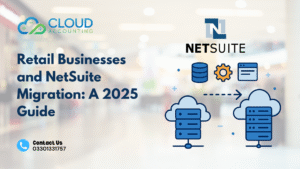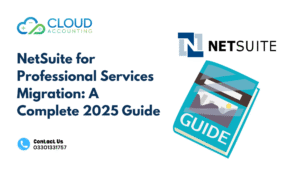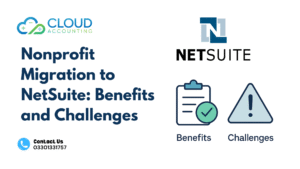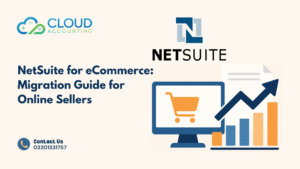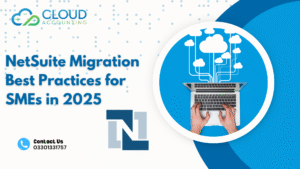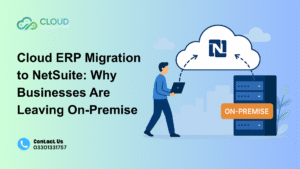When small and medium enterprises (SMEs) reach a certain size, spreadsheets stop cutting it. Business siloes, delayed reporting, manual reconciliations, and disjointed data become painful. That’s when SMEs start looking at Enterprise Resource Planning (ERP) systems that can bring order back into the chaos.
Two names dominate the SME ERP conversation: SAP Business One and Oracle NetSuite. One offers flexibility with on-premise and hosted options; the other is cloud-native, agile, and built for scale. But which is best for growing businesses? And when should you consider SAP Business One to NetSuite Migration?
In this comprehensive guide, we’ll compare features side by side, explore the real cost of ownership, examine scalability, and walk through the step-by-step migration process. If you’re weighing your ERP options in 2025, this is the roadmap you need.
Why SMEs Are Comparing SAP Business One and NetSuite in 2025
Growth often exposes ERP limitations. Many SMEs begin with SAP Business One because it’s affordable and reliable at smaller scales. But as expansion accelerates, reporting delays, multi-entity complexity, and costly add-ons start slowing business down. That’s when SAP Business One to NetSuite Migration becomes a serious consideration.
If you’re stuck patching together reports, struggling with multi-currency setups, or paying too much for IT support, it’s worth evaluating whether NetSuite can future-proof your business.
SAP Business One vs NetSuite: Side-by-Side Feature Comparison
Choosing an ERP isn’t just about the brand it’s about whether the system supports your business today and tomorrow. That’s why many SMEs eventually consider SAP Business One to NetSuite Migration.
Deployment Options
- SAP Business One: On-premise, hosted, or hybrid.
- NetSuite: 100% cloud-native, no servers required.
- Takeaway: SMEs looking to cut IT costs often lean toward SAP Business One to NetSuite Migration.
Core Functionality
- SAP Business One: Strong finance, inventory, purchasing, sales. Advanced features need add-ons.
- NetSuite: Finance, CRM, order management, and more built-in.
- Takeaway: Consolidation is a key driver of SAP Business One to NetSuite Migration.
Reporting & Analytics
- SAP Business One: Good but relies on Crystal Reports or partners for advanced dashboards.
- NetSuite: Real-time dashboards, saved searches, global consolidations.
- Takeaway: Real-time reporting fuels many SAP Business One to NetSuite Migration projects.
Multi-Entity Operations
- SAP Business One: Multi-subsidiary setups require customization.
- NetSuite: Global-ready with multi-entity, multi-currency, tax compliance.
- Takeaway: Expansion is a major trigger for SAP Business One to NetSuite Migration.
Customization & Ecosystem
- SAP Business One: SDKs and partner add-ons.
- NetSuite: SuiteApps, SuiteScript, workflow automation.
- Takeaway: Reliable customization is another reason for SAP Business One to NetSuite Migration.
User Experience
- SAP Business One: Functional but dated UI; manual updates.
- NetSuite: Modern UI, automatic updates.
- Takeaway: Ease of use drives SAP Business One to NetSuite Migration.
Cost of Ownership: The Real Numbers Behind ERP
License fees are just the beginning. Over time, maintenance, upgrades, and IT support often outweigh upfront costs — and that’s why SMEs consider SAP Business One to NetSuite Migration.
Licensing & Subscription
- SAP Business One: Perpetual or subscription via partners. Costs vary widely.
- NetSuite: Subscription-based by users/modules. Predictable monthly fees.
Infrastructure
- SAP Business One: Requires servers, networking, backups, disaster recovery.
- NetSuite: Fully cloud-based — no hardware costs.
Maintenance & Upgrades
- SAP Business One: Manual patches, IT support, downtime.
- NetSuite: Automatic updates with no disruption.
Training
- SAP Business One: Steeper learning curve, especially with customizations.
- NetSuite: Intuitive, less training required long-term.
Scaling Costs
- SAP Business One: More users = more add-ons and hardware.
- NetSuite: Scaling only increases subscription tiers.
Key Takeaway: Over 5–7 years, many SMEs realize SAP Business One to NetSuite Migration reduces total cost of ownership.
Scalability & Integration: Can Your ERP Keep Up?
ERP systems must grow as fast as your business. Here’s where many SMEs discover the limits of SAP and start exploring SAP Business One to NetSuite Migration.
Scalability
- Users: SAP slows with larger teams; NetSuite scales without limits.
- Entities: SAP requires add-ons for subsidiaries; NetSuite handles multi-entity natively.
- Transactions: SAP often needs hardware upgrades; NetSuite handles growth automatically.
Integration
- Third-Party Apps: SAP integrations depend on partner quality. NetSuite offers SuiteApps and APIs.
- Real-Time Data: SAP can lag; NetSuite delivers live dashboards.
Key Takeaway: If scaling or integrations are slowing you down, SAP Business One to NetSuite Migration may be the answer.
SAP Business One to NetSuite Migration: Step-by-Step Roadmap
Here’s the structured approach SMEs take when migrating:
- Assessment & Scoping – Audit current setup and define goals.
- Partner Selection – Choose experienced consultants.
- Data Migration & Clean-Up – Extract, clean, and map data.
- Process Mapping & Configuration – Redesign workflows.
- Integration Build – Connect third-party tools.
- Testing & Validation – Run UAT and end-to-end tests.
- Training & Change Management – Train staff and appoint super-users.
- Go-Live & Support – Execute cutover, monitor KPIs, fine-tune.
Pitfalls to Avoid:
- Poor data quality
- Over-customization
- Lack of training
- Weak partner support
Key Takeaway: A successful SAP Business One to NetSuite Migration isn’t just about data — it’s about process, people, and planning.
Common Migration Pitfalls and How to Avoid Them
Even strong projects can fail without preparation. Here are the top pitfalls:
- Bad Data → Clean it before migration.
- Copying Inefficient Processes → Redesign instead of replicating.
- Over-Customization → Keep it simple.
- Weak Training → Invest early in users.
- Poor Partner Choice → Vet your consultants.
Key Takeaway: Avoiding these traps is critical to smooth SAP Business One to NetSuite Migration.
Benefits of Migrating from SAP Business One to NetSuite
The payoff is real. Here’s what SMEs gain from SAP Business One to NetSuite Migration:
- Real-Time Dashboards – Live reporting for smarter decisions.
- Lower IT Costs – No servers, no downtime.
- Global Readiness – Multi-currency, tax, and subsidiaries.
- Improved Compliance – Automatic updates and security.
- Faster Growth Enablement – Quick entity onboarding and new sales channels.
Key Takeaway: SAP Business One to NetSuite Migration isn’t just an upgrade — it’s a growth enabler.
Case Study: A Growing Distributor
Background
- Mid-sized distributor using SAP Business One in two locations.
- Needed global support and real-time reporting.
Challenges
- Manual month-end consolidations.
- Limited global functionality.
- High IT costs.
Migration Journey
- Partnered with experts.
- Migrated customer, vendor, and product data.
- Phased rollout, starting with finance.
Outcomes
- Month-end close cut from 10 days to 3.
- Real-time dashboards for sales and inventory.
- 30% IT cost reduction.
- Ready for international expansion.
Key Lesson: SMEs see SAP Business One to NetSuite Migration as a strategic growth move, not just a tech change.Final Verdict: Which ERP Wins for SMEs?
- SAP Business One works for smaller, simpler operations.
- NetSuite is the long-term winner for SMEs planning growth, expansion, and global operations.
That’s why many forward-looking companies are planning SAP Business One to NetSuite Migration in 2025.
How to Get Started With Your Migration Today
Here’s a quick checklist to kick off your ERP journey:
- Audit your ERP setup
- Define business goals
- Choose the right partner
- Plan data clean-up early
- Set a phased timeline
Key Takeaway: With planning and expert support, SAP Business One to NetSuite Migration can be smooth and ROI-driven.
Don’t wait until your ERP holds back growth. Contact us now to design your SAP Business One to NetSuite Migration strategy.



